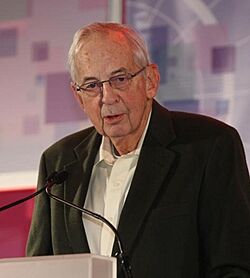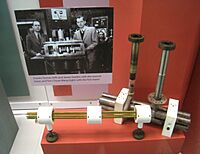James P. Gordon facts for kids
Quick facts for kids
James P. Gordon
|
|
|---|---|

James P. Gordon (1928–2013)
|
|
| Born | March 20, 1928 |
| Died | June 21, 2013 (aged 85) Manhattan, New York, New York
|
| Nationality | American |
| Alma mater | Columbia University Massachusetts Institute of Technology |
| Scientific career | |
| Fields | Physics |
| Institutions | Bell Labs |
| Doctoral advisor | Charles Hard Townes |
James Power Gordon (March 20, 1928 – June 21, 2013) was an American scientist. He was a physicist who studied light and how tiny particles like atoms behave.
He helped build the first maser in 1954. A maser is like a laser, but it uses microwaves instead of light. He also helped create important ideas about how information travels using light. His work led to discoveries like the Gordon-Haus effect, which is important for sending information through optical fibers. James Gordon was a member of important science groups like the National Academy of Engineering and the National Academy of Sciences.
Contents
About James P. Gordon
James P. Gordon was born in Brooklyn, New York, on March 20, 1928. He grew up in Forest Hills and Scarsdale. His father was a lawyer.
Education and Early Career
James went to Scarsdale High School and Phillips Exeter Academy. In 1949, he earned a bachelor's degree from the Massachusetts Institute of Technology (MIT). He then went to Columbia University for his advanced degrees. He earned his master's degree in 1951 and his PhD in physics in 1955.
For his PhD, he worked with his professor, Charles H. Townes. Together, they designed and built the very first maser. This invention was a big deal! Charles H. Townes later won the Nobel Prize in Physics in 1964 for this work.
After finishing his studies, James Gordon started working at AT&T Bell-Laboratories in 1955. He stayed there until he retired in 1996. For many years, he led the Quantum Electronics Research Department. This department studied how light and matter interact.
Family Life and Hobbies
In 1960, James married Susanna Bland Waldner. She used to be a computer programmer at Bell-Labs. They had three children: James Jr., Susanna, and Sara. James Gordon lived in Rumson, New Jersey. He passed away in 2013 at the age of 85.
Besides his science work, James Gordon was a great athlete. He played platform tennis and won national championships. He won the men's doubles in 1959 and mixed doubles in 1961 and 1962.
James also had a brother named Robert S. Gordon Jr. Robert was a scientist too. He helped set up a clinic in East Pakistan to study cholera, a serious disease. An award called the Gordon Lecture in Epidemiology is given each year to honor his work.
James Gordon's Scientific Discoveries
Lasers and Resonators
When James Gordon was a student, he helped create the maser. The maser was a very important invention. It was the first step towards creating the laser. Lasers are now used in many things, from DVD players to surgery.
Later, James Gordon studied how lasers work inside a special setup called a resonator. He helped explain how light beams behave inside these resonators. This work was important for making lasers better. He also helped find a way to make very short laser pulses. These super-fast pulses are useful in many modern laser technologies.
Quantum Information
In 1962, James Gordon looked at how the rules of quantum mechanics affect how much information can be sent. He thought about how tiny particles, like electrons, carry information. He came up with an idea for a "quantum" version of a famous formula by Claude Shannon. This formula helps us understand how much information can travel through a channel.
Gordon's idea was later proven by another scientist, Alexander Holevo. It is now called Holevo's theorem. This theorem is a key part of the field of quantum information theory. This field studies how to use quantum physics to process and send information.
Atom Diffusion
James Gordon also worked with another scientist named Arthur Ashkin. They studied how to move tiny particles, like atoms, using laser beams. Gordon helped create the first theory that explained how laser light could push and pull on these tiny particles.
Together, Gordon and Ashkin figured out how atoms move when they are trapped by light. This work was very important. It led to the development of atom trapping and optical tweezers. Optical tweezers are tools that use light to hold and move very small things, like cells. Arthur Ashkin won the Nobel Prize in Physics in 2018 for his work on optical tweezers.
Solitons and Optical Communications
A big part of James Gordon's later work was about solitons. Solitons are special light waves that can travel long distances in optical fibers without losing their shape. This is very important for sending information through the internet.
In 1986, James Gordon explained a theory about how solitons change their frequency. In the same year, he worked with Professor H. A. Haus. They predicted and measured something called the Gordon-Haus effect. This effect describes how tiny changes in light can cause problems when sending information using solitons. It was a key discovery for making fiber optic systems work well.
Gordon also worked with Linn F. Mollenauer. They predicted another effect, now called the Gordon-Mollenauer effect. This effect showed how noise in light could make it harder to use solitons for certain types of communication.
One of his last big contributions was explaining polarization mode dispersion (PMD). This is another factor that can affect how well information travels through optical fibers. His work helped create the standard way to understand how light's polarization changes in fibers.
Awards and Honors
James P. Gordon received many awards and honors for his important scientific work:
- Fellow of the American Physical Society
- Fellow of the Optical Society of America (OSA)
- Life fellow of IEEE
- Charles Hard Townes Award (OSA, 1981)
- National Academy of Engineering (member since 1985)
- National Academy of Sciences (member since 1988)
- Max Born Award (OSA, 1991)
- Willis E. Lamb Award for laser science and quantum optics (2001)
- Fredric Ives Medal/Jarus W. Quinn Prize (OSA, 2002)
- Honorary Member of the Optical Society (OSA, 2011)


